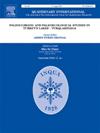西北伊比利亚边缘远端海因里希期4和5期沉积和缺氧的变化
IF 1.8
3区 地球科学
Q3 GEOGRAPHY, PHYSICAL
引用次数: 0
摘要
这项工作旨在研究西北伊比利亚大陆边缘远端地区海因里希冰期(与海因里希事件同时代的寒冷时期)HS5和HS4的沉积变化,这方面的文献很少。分析了模型年龄的物理化学、地球化学和矿物学数据以及放射性碳定年。HS5(记录在~ 46.9 ~ 43.9 ka之间);持续时间~ 3.0 ka),沉积物堆积速率(~ 20 cm/ka)高于HS4(记录在~ 40.7 ~ 36.8 ka之间);持续时间~ 3.9 ka;∼3.4厘米/卡)。这两个事件的标志是沉积物变暗,岩屑颗粒尺寸增大(≥350 μm),磁化率值增大,沉积物电阻率和密度增大,Fe/Ca和Ti/Ca比值增大,稀土(ree)含量增加,石英、长石、层状硅酸盐、厚皮新红毛藻(Neogloboquadrina pachyderma)、球状球藻(Globigerina bulloides) δ18O等矿物也增加。这些事件的特征还包括孔隙度分数(由于细碎屑物质的堆积)、方解石、黄铁矿、水合铁含量、海面温度和输出生产力(Pexp)的降低。最大的矿物学和地球化学变化与冰山融化导致的冰屑沉积有关。在HE5和HE4之间,Pexp较高。然而,V/(V + Ni)比值表明,在分析时期(~ 47.0 ~ 36.2 ka),沉积物的氧合作用较差,但从HS5末期(~ 43.9 ~ 43.5 ka)开始,由于与冰盖减少有关的气候条件的改善,δ18O值突然降低,沉积物的氧合作用明显改善。Pexp值的降低以及黄铁矿和水合铁含量的降低使我们可以推断HE5和HE4期间的氧短缺不是由于有机物降解量的增加引起的;正如几项研究表明的那样,这应该是北大西洋深水(NADW)产量减弱的结果。在HS5期间,几个加热和冷却脉冲(由δ18O值表示)出现在相对温暖的阶段,IRD放电密度最高。本文章由计算机程序翻译,如有差异,请以英文原文为准。
Changes in the sedimentation and oxygen depletion during the Heinrich stadials 4 and 5 in a distal region of the NW Iberian Margin
This work aims to study changes in sedimentation during the Heinrich Stadials (cold periods contemporary with Heinrich Events, HE) HS5 and HS4 in a distal region of the NW Iberian Continental Margin, which has been poorly documented. Physicochemical, geochemical and mineralogical data and radiocarbon dates for the model age were analyzed. During the HS5 (recorded between ∼46.9 and 43.9 ka; duration ∼3.0 ka), the sediment accumulation rate was higher (∼20 cm/ka) than HS4 (recorded between ∼40.7 and 36.8 ka; duration ∼3.9 ka; ∼3.4 cm/ka). Both events were marked by the darkening of the sediment and the increase in lithic grains >350 μm in size, magnetic susceptibility values, sediment resistivity and density, Fe/Ca and Ti/Ca ratios, rare earths (REEs) contents, among other lithogenic chemical elements, minerals such as quartz, feldspars, phyllosilicates, Neogloboquadrina pachyderma, Globigerina bulloides δ18O. These events were also marked by reduced fractional porosity (due to the accumulation of fine detrital material), calcite, pyrite, ferrihydrite contents, sea surface temperatures, and exported productivity (Pexp). The greatest mineralogical and geochemical changes are associated with the deposition of ice-rafted debris (IRD) due to the melting of icebergs. The Pexp was higher between the HE5 and HE4. However, the values of the V/(V + Ni) ratio indicate that during the analyzed period (∼47.0–36.2 ka) the oxygenation of the sediments was poor, but improved considerably from the end of the HS5 (between ∼43.9 and 43.5 ka) associated with a sudden reduction in δ18O values, due to an improvement in climatic conditions related to the reduction of the ice caps. The reduction in Pexp values and the decrease in pyrite and ferrihydrite allow us to deduce that during HE5 and HE4, the oxygen shortage was not caused by a higher amount of organic matter degradation; it should have been a consequence of the weakening in the North Atlantic Deep Water (NADW) production, as suggested by several studies. During HS5, several pulses of heating and cooling (indicated by the δ18O values), with the highest density of IRD discharges, occurred in a relatively warmer phase.
求助全文
通过发布文献求助,成功后即可免费获取论文全文。
去求助
来源期刊

Quaternary International
地学-地球科学综合
CiteScore
5.60
自引率
4.50%
发文量
336
审稿时长
3 months
期刊介绍:
Quaternary International is the official journal of the International Union for Quaternary Research. The objectives are to publish a high quality scientific journal under the auspices of the premier Quaternary association that reflects the interdisciplinary nature of INQUA and records recent advances in Quaternary science that appeal to a wide audience.
This series will encompass all the full spectrum of the physical and natural sciences that are commonly employed in solving Quaternary problems. The policy is to publish peer refereed collected research papers from symposia, workshops and meetings sponsored by INQUA. In addition, other organizations may request publication of their collected works pertaining to the Quaternary.
 求助内容:
求助内容: 应助结果提醒方式:
应助结果提醒方式:


